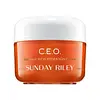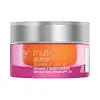What's inside
What's inside
 Key Ingredients
Key Ingredients

 Benefits
Benefits

 Concerns
Concerns

 Ingredients Side-by-side
Ingredients Side-by-side

Water
Skin ConditioningSqualane
EmollientDicaprylyl Carbonate
EmollientTetrahexyldecyl Ascorbate
AntioxidantC10-18 Triglycerides
EmollientPEG-8 Beeswax
EmulsifyingPolyglyceryl-6 Distearate
EmulsifyingTapioca Starch
Hydrogenated Vegetable Oil
EmollientPrunus Amygdalus Dulcis Oil
Skin ConditioningCitric Acid
BufferingPPG-12/Smdi Copolymer
EmollientGlycerin
HumectantCitrus Tangerina Peel Oil
MaskingSodium Acrylates Copolymer
Bisabolol
MaskingJojoba Esters
EmollientTocopherol
AntioxidantCaprylic/Capric Triglyceride
MaskingLimonene
PerfumingPhenoxyethanol
PreservativeLecithin
EmollientNylon-12
Rosa Centifolia Flower Wax
Skin ConditioningRosa Damascena Flower Wax
MaskingSodium Phytate
Cetyl Alcohol
EmollientPolyglyceryl-3 Beeswax
EmulsifyingButylene Glycol
HumectantCaprylyl Glycol
EmollientAlcohol Denat.
AntimicrobialChlorphenesin
AntimicrobialCitrus Australasica Fruit Extract
AntioxidantPolymethylsilsesquioxane
Terminalia Ferdinandiana Fruit Extract
AntioxidantButyrospermum Parkii Butter Extract
Skin ConditioningCamellia Sinensis Leaf Extract
AntimicrobialCitrus Junos Fruit Extract
Skin ConditioningCurcuma Longa Root Extract
MaskingEuterpe Oleracea Fruit Extract
Lippia Citriodora Flower Extract
PerfumingOenothera Biennis Seed Extract
Skin ConditioningRosa Canina Fruit Extract
AstringentAlteromonas Ferment Extract
Skin ConditioningBenzyl Alcohol
PerfumingSodium Hyaluronate
HumectantLinalool
PerfumingDehydroacetic Acid
PreservativeWater, Squalane, Dicaprylyl Carbonate, Tetrahexyldecyl Ascorbate, C10-18 Triglycerides, PEG-8 Beeswax, Polyglyceryl-6 Distearate, Tapioca Starch, Hydrogenated Vegetable Oil, Prunus Amygdalus Dulcis Oil, Citric Acid, PPG-12/Smdi Copolymer, Glycerin, Citrus Tangerina Peel Oil, Sodium Acrylates Copolymer, Bisabolol, Jojoba Esters, Tocopherol, Caprylic/Capric Triglyceride, Limonene, Phenoxyethanol, Lecithin, Nylon-12, Rosa Centifolia Flower Wax, Rosa Damascena Flower Wax, Sodium Phytate, Cetyl Alcohol, Polyglyceryl-3 Beeswax, Butylene Glycol, Caprylyl Glycol, Alcohol Denat., Chlorphenesin, Citrus Australasica Fruit Extract, Polymethylsilsesquioxane, Terminalia Ferdinandiana Fruit Extract, Butyrospermum Parkii Butter Extract, Camellia Sinensis Leaf Extract, Citrus Junos Fruit Extract, Curcuma Longa Root Extract, Euterpe Oleracea Fruit Extract, Lippia Citriodora Flower Extract, Oenothera Biennis Seed Extract, Rosa Canina Fruit Extract, Alteromonas Ferment Extract, Benzyl Alcohol, Sodium Hyaluronate, Linalool, Dehydroacetic Acid
Butyl Methoxydibenzoylmethane 3%
UV AbsorberHomosalate 7%
Skin ConditioningEthylhexyl Salicylate 4.5%
UV AbsorberOctocrylene 10%
UV AbsorberWater
Skin ConditioningPropanediol
SolventDimethicone
EmollientCetearyl Alcohol
EmollientPotassium Cetyl Phosphate
EmulsifyingTetrahexyldecyl Ascorbate
AntioxidantErgothioneine
AntioxidantMannitol
HumectantBacillus/Sea Salt Ferment Filtrate
Skin ConditioningMyristyl Nicotinate
Skin ConditioningCitrus Japonica Fruit Extract
Skin ConditioningOryza Sativa Germ Extract
EmollientMorinda Citrifolia Extract
AstringentOryza Sativa Extract
AbsorbentGlycerin
HumectantGlycine Soja Oil
EmollientTocopheryl Acetate
AntioxidantCetearyl Glucoside
EmulsifyingLecithin
EmollientUbiquinone
AntioxidantButylene Glycol
Humectant1,2-Hexanediol
Skin ConditioningDecyl Glucoside
CleansingHexylene Glycol
EmulsifyingCaprylyl Glycol
EmollientPolysilicone-11
Polyglyceryl-3 Diisostearate
EmulsifyingAcrylates/C10-30 Alkyl Acrylate Crosspolymer
Emulsion StabilisingSodium Acrylates Copolymer
Caprylhydroxamic Acid
Aminomethyl Propanol
BufferingDisodium EDTA
Parfum
MaskingPhenoxyethanol
PreservativeSodium Benzoate
MaskingCitric Acid
BufferingLimonene
PerfumingLinalool
PerfumingBenzyl Benzoate
AntimicrobialGeraniol
PerfumingCitral
PerfumingCI 19140
Cosmetic ColorantCI 16035
Cosmetic ColorantButyl Methoxydibenzoylmethane 3%, Homosalate 7%, Ethylhexyl Salicylate 4.5%, Octocrylene 10%, Water, Propanediol, Dimethicone, Cetearyl Alcohol, Potassium Cetyl Phosphate, Tetrahexyldecyl Ascorbate, Ergothioneine, Mannitol, Bacillus/Sea Salt Ferment Filtrate, Myristyl Nicotinate, Citrus Japonica Fruit Extract, Oryza Sativa Germ Extract, Morinda Citrifolia Extract, Oryza Sativa Extract, Glycerin, Glycine Soja Oil, Tocopheryl Acetate, Cetearyl Glucoside, Lecithin, Ubiquinone, Butylene Glycol, 1,2-Hexanediol, Decyl Glucoside, Hexylene Glycol, Caprylyl Glycol, Polysilicone-11, Polyglyceryl-3 Diisostearate, Acrylates/C10-30 Alkyl Acrylate Crosspolymer, Sodium Acrylates Copolymer, Caprylhydroxamic Acid, Aminomethyl Propanol, Disodium EDTA, Parfum, Phenoxyethanol, Sodium Benzoate, Citric Acid, Limonene, Linalool, Benzyl Benzoate, Geraniol, Citral, CI 19140, CI 16035
 Reviews
Reviews

Ingredients Explained
These ingredients are found in both products.
Ingredients higher up in an ingredient list are typically present in a larger amount.
Butylene Glycol (or BG) is used within cosmetic products for a few different reasons:
Overall, Butylene Glycol is a safe and well-rounded ingredient that works well with other ingredients.
Though this ingredient works well with most skin types, some people with sensitive skin may experience a reaction such as allergic rashes, closed comedones, or itchiness.
Learn more about Butylene GlycolCaprylyl Glycol is a humectant and emollient, meaning it attracts and preserves moisture.
It is a common ingredient in many products, especially those designed to hydrate skin. The primary benefits are retaining moisture, skin softening, and promoting a healthy skin barrier.
Though Caprylyl Glycol is an alcohol derived from fatty acids, it is not the kind that can dry out skin.
This ingredient is also used as a preservative to extend the life of products. It has slight antimicrobial properties.
Learn more about Caprylyl GlycolCitric Acid is an alpha hydroxy acid (AHA) naturally found in citrus fruits like oranges, lemons, and limes.
Like other AHAs, citric acid can exfoliate skin by breaking down the bonds that hold dead skin cells together. This helps reveal smoother and brighter skin underneath.
However, this exfoliating effect only happens at high concentrations (20%) which can be hard to find in cosmetic products.
Due to this, citric acid is usually included in small amounts as a pH adjuster. This helps keep products slightly more acidic and compatible with skin's natural pH.
In skincare formulas, citric acid can:
While it can provide some skin benefits, research shows lactic acid and glycolic acid are generally more effective and less irritating exfoliants.
Most citric acid used in skincare today is made by fermenting sugars (usually from molasses). This synthetic version is identical to the natural citrus form but easier to stabilize and use in formulations.
Read more about some other popular AHA's here:
Learn more about Citric AcidGlycerin is already naturally found in your skin. It helps moisturize and protect your skin.
A study from 2016 found glycerin to be more effective as a humectant than AHAs and hyaluronic acid.
As a humectant, it helps the skin stay hydrated by pulling moisture to your skin. The low molecular weight of glycerin allows it to pull moisture into the deeper layers of your skin.
Hydrated skin improves your skin barrier; Your skin barrier helps protect against irritants and bacteria.
Glycerin has also been found to have antimicrobial and antiviral properties. Due to these properties, glycerin is often used in wound and burn treatments.
In cosmetics, glycerin is usually derived from plants such as soybean or palm. However, it can also be sourced from animals, such as tallow or animal fat.
This ingredient is organic, colorless, odorless, and non-toxic.
Glycerin is the name for this ingredient in American English. British English uses Glycerol/Glycerine.
Learn more about GlycerinLecithin is a term for a group of substances found in the cell membranes of plants, animals, and humans. They are made up of mixture of phospholipids.
This ingredient has emollient and emulsifying properties.
As an emollient, lecithen helps soften the skin and creates a barrier to keep moisture in.
As an emulsifier, it also helps prevent water and oil ingredients from separating. Lecithin can also help ingredients be better absorbed by the skin.
This is because the phospholipids in lecithin produce liposomes. Liposomes help other ingredients get through the skin barrier.
Depending on the source of this ingredient, lecithin may not be fungal acne safe. This is because some sources of lecithin come from soybean oil, which may feed the malassezia yeast that feeds fungal acne.
We recommend reaching out to the brand you are purchasing from to inquire about the source of their lecithin.
Some other names for this ingredient include soy lecithin and deoiled soy lecithin.
Learn more about LecithinLimonene is a fragrance that adds scent and taste to a formulation.
It's found in the peel oil of citrus fruits and other plants such as lavender and eucalyptus. The scent of limonene is generally described as "sweet citrus".
Limonene acts as an antioxidant, meaning it helps neutralize free radicals.
When exposed to air, oxidized limonene may sensitize the skin. Because of this, limonene is often avoided by people with sensitive skin.
The term 'fragrance' is not regulated in many countries. In many cases, it is up to the brand to define this term. For instance, many brands choose to label themselves as "fragrance-free" because they are not using synthetic fragrances. However, their products may still contain ingredients such as essential oils that are considered a fragrance.
Learn more about LimoneneLinalool is a fragrance and helps add scent to products. It's derived from common plants such as cinnamon, mint, citrus, and lavender.
Like Limonene, this ingredient oxidizes when exposed to air. Oxidized linalool can cause allergies and skin sensitivity.
This ingredient has a scent that is floral, spicy tropical, and citrus-like.
Learn more about LinaloolPhenoxyethanol is a preservative that has germicide, antimicrobial, and aromatic properties. Studies show that phenoxyethanol can prevent microbial growth. By itself, it has a scent that is similar to that of a rose.
It's often used in formulations along with Caprylyl Glycol to preserve the shelf life of products.
We don't have a description for Sodium Acrylates Copolymer yet.
Tetrahexyldecyl Ascorbate (THD) is a stable and oil-soluble form of Vitamin C.
THD is special in that it has the ability to travel deeper into skin than traditional ascorbic acid while maintaining the same skin benefits (double win!).
Because it’s oil-soluble, THD dives deep into your skin’s fatty layers (think ceramides and cholesterol) to fight off the kind of free radicals that mess with your skin barrier. This makes it a great pair with water-based vitamin C (ascorbic acid) that mainly works on the surface.
Even at just 0.1%, THD is already showing great antioxidant activity. When used up to 2%, it helps keep your skin happy and calm, especially when it’s stressed from pollution or sun.
Want to fade dark spots or tackle hyperpigmentation? You’ll want 5% or more. Pairing it with brightening buddies like niacinamide or licorice root gives even better results. One study even used 30% THD with other brighteners and saw real results on stubborn discoloration, even in melasma-prone skin.
A note on THD: It’s has a slightly silky, oily texture and usually shows up colorless or pale yellow (though the exact shade can vary by supplier).
While you can sneak it into water-based formulas, it really shines when paired with silicones or oils, which help your skin soak it up better.
THD is pretty stable, but it’s still vulnerable to degradation like ascorbic acid. Too much light or heat (above 113°F / 45°C) can break it down over time. Go for dark and opaque packaging that keeps it safe and shady!
Read more about other types of Vitamin C:
Learn more about Tetrahexyldecyl AscorbateWater. It's the most common cosmetic ingredient of all. You'll usually see it at the top of ingredient lists, meaning that it makes up the largest part of the product.
So why is it so popular? Water most often acts as a solvent - this means that it helps dissolve other ingredients into the formulation.
You'll also recognize water as that liquid we all need to stay alive. If you see this, drink a glass of water. Stay hydrated!
Learn more about Water